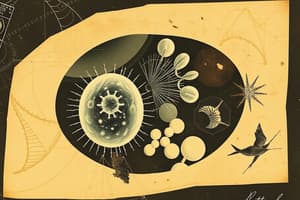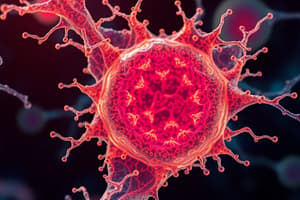Podcast
Questions and Answers
Who first observed cells in a thin slice of cork?
Who first observed cells in a thin slice of cork?
- Anton Van Leeuwenhoek (correct)
- Schleiden and Schwann
- J.E. Purkinje
- Robert Brown
Who made the groundbreaking discovery of the first free-living cell?
Who made the groundbreaking discovery of the first free-living cell?
- Schleiden and Schwann
- Robert Hooke
- Anton Van Leeuwenhoek (correct)
- J.E. Purkinje
Which scientist discovered the nucleus in 1831?
Which scientist discovered the nucleus in 1831?
- Robert Brown (correct)
- J.E. Purkinje
- Schleiden and Schwann
- Anton Van Leeuwenhoek
According to the cell theory, what is the basic unit of structure and function in living organisms?
According to the cell theory, what is the basic unit of structure and function in living organisms?
What is the essential substance within cells that comprises water, ions, salts, organic molecules, cell organelles, and a nucleus?
What is the essential substance within cells that comprises water, ions, salts, organic molecules, cell organelles, and a nucleus?
Who proposed the cell theory in 1838?
Who proposed the cell theory in 1838?
What is the main function of ribosomes in a cell?
What is the main function of ribosomes in a cell?
Which organelle is responsible for capturing light energy and converting it into chemical energy?
Which organelle is responsible for capturing light energy and converting it into chemical energy?
Where are chloroplasts primarily found within plant cells?
Where are chloroplasts primarily found within plant cells?
Which type of plastid is involved in the synthesis and storage of pigments other than chlorophyll?
Which type of plastid is involved in the synthesis and storage of pigments other than chlorophyll?
What substances are stored by leucoplasts within plant cells?
What substances are stored by leucoplasts within plant cells?
What is the primary role of chromoplasts in plant cells?
What is the primary role of chromoplasts in plant cells?
Flashcards are hidden until you start studying
Study Notes
Cell Biology
- Cells are the structural and fundamental units of life, capable of performing basic functions of all living organisms.
- Cytology is the scientific study of the structure and composition of cells.
History of Cell Discovery
- Robert Hooke first observed cells in a thin slice of cork in 1665, marking the beginning of our understanding of cellular existence.
- Anton Van Leeuwenhock discovered the first free-living cell in 1674.
- Robert Brown discovered the nucleus in 1831.
- J.E.Purkinje discovered protoplasm in 1839.
Cell Theory
- The cell theory was given by Schleiden and Schwann in 1838, stating that:
- All living things are made up of cells.
- Cells come from pre-existing cells through the process of cell division.
Cell Organelles
- Protoplasm is the essential substance within cells, comprising water, ions, salts, organic molecules, cell organelles, and a nucleus, existing in sol-gel states.
- Ribosomes translate genetic instructions from mRNA to build proteins essential for cell structure and function.
- Plastids are membrane-bound organelles found in plant cells, responsible for crucial processes like photosynthesis.
Types of Plastids
- Chloroplasts:
- Contain chlorophyll pigments, essential for photosynthesis.
- Found in cells of green plant tissues.
- Chlorophyll absorbs light energy and converts it into chemical energy.
- Chromoplasts:
- Contain various pigments such as carotenoids (e.g., carotenes and xanthophylls).
- Involved in the synthesis and storage of pigments other than chlorophyll.
- Give fruits and flowers their characteristic colors.
- Leucoplasts:
- Colorless and do not contain pigments like chlorophyll or carotenoids.
- Involved in the storage of starch, lipids, or proteins.
Studying That Suits You
Use AI to generate personalized quizzes and flashcards to suit your learning preferences.




